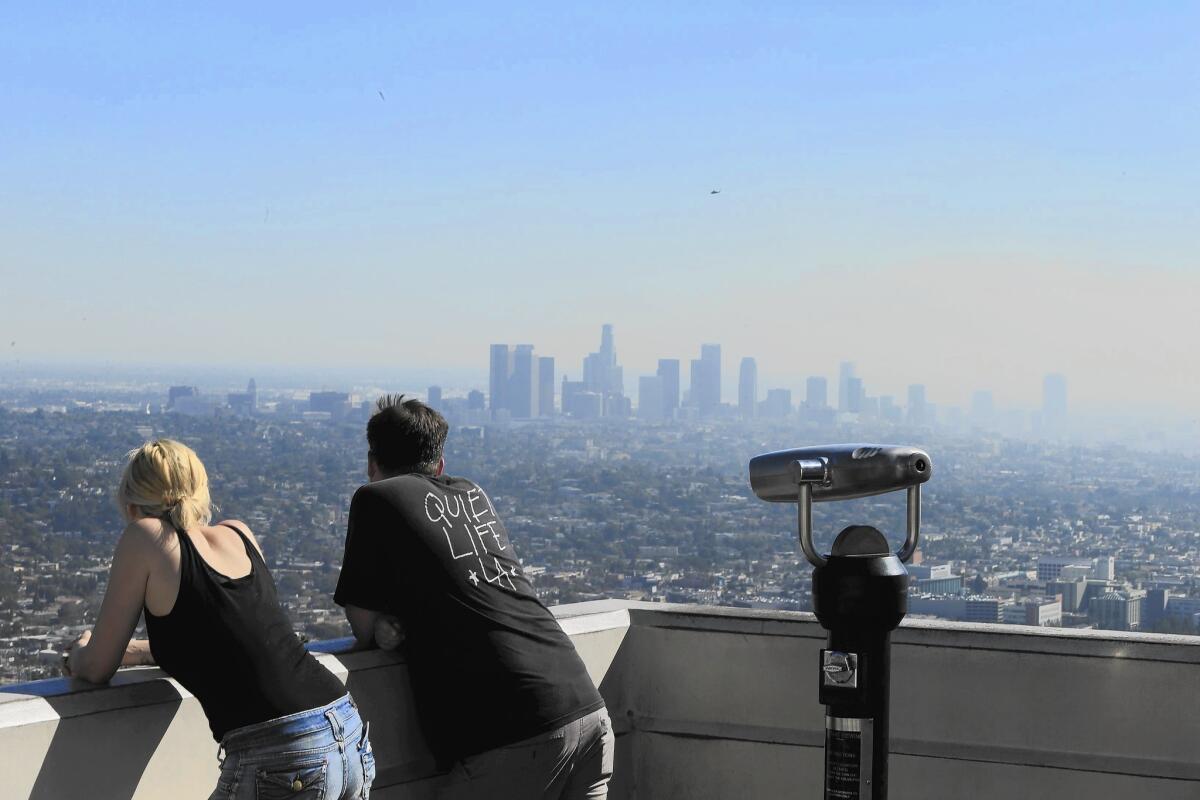EPA’s proposed ozone limit faces political, cost hurdles

- Share via
Reporting from WASHINGTON — The Obama administration’s long-awaited announcement Wednesday that it wants to toughen limits on smog-forming ozone immediately generated questions about whether the plan can survive the current political climate and how much its cost will factor in reaching the goal.
The Environmental Protection Agency proposed strengthening the federal standard for ozone in the air to 65 to 70 parts per billion from its current standard of 75 parts per billion.
The agency and backers of the tighter limit contend that governments, businesses and people in the areas affected by smog will have lots of time to meet the stricter threshold and that evolving technology can help cut pollution at a reasonable cost. Further, the improvements in public health from removing the lung-damaging pollution will save millions of dollars in lost workdays and healthcare costs, they say.
Republicans and business lobbying groups such as the U.S. Chamber of Commerce strongly oppose strengthening the ozone standard, arguing that it would be catastrophically expensive. Republican lawmakers who are set to take over Congress in January are considering a range of options to scuttle the rule, including amending the landmark Clean Air Act.
“Today we are breathing the cleanest air since the Clean Air Act was passed in the 1970s, and our country should first look to meet the current ozone standard before we even consider adding more burdensome, costly mandates,” said Sen. James M. Inhofe (R-Okla.), who will head the Senate’s environment committee next year.
The argument pitting economic cost against health benefits is a familiar one in environmental regulations. Industry, at the start of a rule-making process, consistently argues that the step being proposed is too costly, said Vince Albanese, former president of the Institute of Clean Air Companies, a trade group for pollution control equipment makers.
But a recent report by the nonpartisan Congressional Research Service concluded that cost estimates for the ozone plan are highly conjectural, in part because the price of the technology needed to make changes historically falls and the implementation period could take up to 20 years.
Still, reducing pollution could get more expensive, Albanese said, though not necessarily prohibitively so. With so much ozone cut already, mostly from reductions in power plant pollution over the last 40 years, there are fewer places to look for reductions and they could be more costly.
Taking further steps could affect more businesses and consumers, Albanese said, depending on the stringency of the final standard, to be set in October.
“Getting … emissions lower from leaf blowers is not the same as putting equipment on an 800-megawatt power plant,” he said.
Ozone is created when unstable gases are released during combustion, whether at power plants and factories or in vehicle engines. The pollutants react with sunlight to create ozone, which can trigger asthma attacks, worsen heart and lung disease and lead to premature deaths.
The EPA arrived at the proposal after staffers and its science advisory council reviewed more than 1,000 studies on ozone’s health effects and concluded that the current standard of 75 parts per billion did not protect people’s health. They recommended that the limit be tightened to 60 to 70 parts per billion.
Industry groups dispute the certainty of the science, but half a dozen congressional and business opponents of the new limit contacted by the Los Angeles Times provided no peer-reviewed research that supports maintaining the current standard. The American Petroleum Institute pointed to one study that it funded.
Once the rule is finalized, counties will have three years to gauge ozone levels, followed by a few more years to develop implementation plans and then work toward compliance.
Nationwide, 715 counties have EPA-certified air quality monitoring equipment. If the ozone limit is set at 70 parts per billion, the EPA expects only nine counties outside California to be short of compliance. In California, 29 counties would fail to meet the standard.
The worse a county’s smog, the longer it will have to meet the new standard. Because California’s smog problem is considered uniquely stubborn, it will have until 2037 to comply if the plan is approved.
For most counties, meeting the standard would not be as heavy a lift because a host of other clean air rules introduced by the EPA would reduce the pollutants that are precursors to ozone, the agency said.
To industry, an ozone mandate is seen as excessive regulation.
“EPA already has air quality rules on the books and we are improving air quality,” said Howard Feldman, director of regulatory affairs at the petroleum institute. “So we don’t need another layer on top of that, which is what a tighter ozone standard would do.”
With major industries backing them, some in Congress are ready to battle President Obama over the ozone limit. They are banking, in part, that he has little stomach for the fight, given that he shelved a tighter standard in 2011 at the start of his reelection bid.
“The administration only has so much political capital at its disposal. It has made clear that controlling greenhouse gases is its legacy issue,” said Scott Segal, a lobbyist for the energy industry in Washington. “It is unclear that the administration has the bandwidth to sustain both rules.”
Proponents of the new limit say the backlash the president suffered from supporters by ditching a new ozone standard three years ago would make him more determined to stick with it now.
“This is fast approaching a legacy issue for the president,” said S. William Becker, executive director of the National Assn. of Clean Air Agencies, a coalition of state regulators. “Because he delayed the decision before and in light of the fact that he has been such an advocate for sound science, he has no place to go but listen to recommendations of EPA’s science advisors. There will be attempts by Congress to delay it or starve the funding for it, but I can’t see the president going along with it.”
More to Read
Sign up for Essential California
The most important California stories and recommendations in your inbox every morning.
You may occasionally receive promotional content from the Los Angeles Times.











